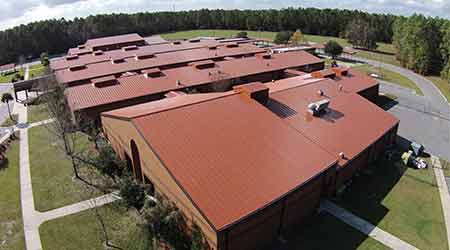A new roof helped the maintenance and engineering technicians work more efficiently when it come to routine maintenance and leaks
Part three of a three part series.
The three reroofing projects completed by the Camden County (Ga.) School System between 2013 and 2015 eliminated a host of problems related to deteriorating roofs on elementary schools. They also have helped the district’s maintenance and engineering technicians work more effectively when it comes to troubleshooting interior water leaks.
“We have very hard water, which eats through copper pipes that most of our buildings are plumbed with,” says Mike Blackerby, the district’s director of operations. “Most of our plumbing is in the ceiling. In these three buildings, if the ceiling tiles are wet, we no longer assume it’s the roof. We assume it’s a water pipe. There’s no guesswork. We know we’ve got a water pipe leak somewhere.”
Efficiency is essential for Blackerby’s department, given the staffing considerations facing many publicly funded school districts that result from ongoing budget and financing issues.
“We feel at times that we work with almost a skeleton crew, given the number of facilities and the amount of land we have to maintain,” Blackerby says. “We do it with a relatively small group of employees and a relatively small budget compared to school systems around us that are of a similar size. We try to handle all of our maintenance in-house, whether it’s HVAC or electrical or grounds or plumbing.
“We have a very fiscally responsible superintendent who actually came up through the operations side of things. We don’t cut costs and sacrifice quality, but we’re very cognizant of how much we spend on operations. Anything we can save, whether it’s general maintenance or energy savings or anything else related to the operations budget, goes right back into the instructional budget of the schools, which is what we’re here for.”
— Dan Hounsell




















